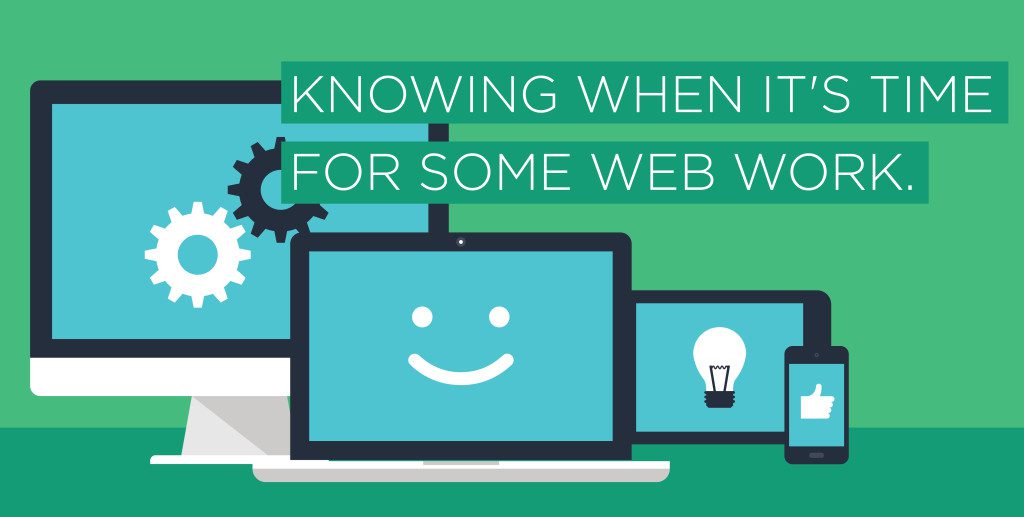Work your Website – Refresh or Redesign?

Not so long ago, simply having a website got the job done — you could check it off your marketing to-do list and happily go about your business. Of course, that is certainly not the case anymore. Websites are now living things that exist to work — for you, your organization or your business. In turn, you need to work for them, conducting regular evaluations to make sure your site is doing what you need it to.
When taking stock of your web presence, making adjustments comes down to two things: deciding to completely overhaul an outdated site or doing a refresh on your existing one. As one of our core services, we can help you wade through the digital landscape and understand how to make your website live happily in that world. Whether it’s design, development or content management, we’ve got you covered.
RECOGNIZING THE NEED FOR A CHANGE
- Non-responsive. This one should go without mentioning, so we’ll get it out of the way: If your site isn’t viewable on mobile devices, it’s time for a comprehensive redesign and a possible switch of CMS. Important for user experience? Yes. But the more central concern is that it can affect your search rankings on Google.
- Lacking results. Your website exists to build your customer base or communicate with your target audience. If it’s not doing this, it’s just useless web real estate.
- To determine if your site is showing up for its nine-to-five and working hard for you, consider the following:
- Is there a call-to-action that jumps out at users, such as a newsletter sign-up? Are you collecting quality data from this?
- Once someone visits your landing page, how long do they stay, and are they persuaded to dig deeper? What can you change to entice users to stick around longer?
- To determine if your site is showing up for its nine-to-five and working hard for you, consider the following:
- Matchy, matchy. All your marketing activities should act like a well put-together outfit, with each piece complementing the others. Think about these questions: Does the look and feel of your site match your organization’s voice and speak directly to your target audience? Does it fit with whatever else you have out there in both the digital and physical world?
- Moving the target. Have you altered your marketing strategy recently? Whether it’s small adjustments or brand-new goals, it’s important that your site reflects this and helps you achieve any new objectives.
- The functionality test. It might look great, but is your site user friendly? We’re big fans of form and function (or rhyme and reason, if you will) and believe that a successful website must have both.
- What to consider: Is important content easy to find (especially your contact information)? Is any part of the navigation confusing? Is the search function working well?
- Here’s a suggestion: If you don’t think you can be objective about your own site, have someone outside the organization take a look around and give you some constructive feedback
- Considering content. Is it time to focus on some better content? We understand (and agree). Content development is important throughout all of your marketing activities but especially on your website. If you start boosting your content (implementing a blog, perhaps), you want to make sure users can find it and that it helps boost your SEO. The goal: You want search engines to find and index your content. For this, adding a blog section to your site or another refresh could be in order
- The big ones. If you’ve had a major change in your business model, organizational structure or brand image, your website should be one of the first places to make sure either a new design reflects that change and/or you’re your audience has all the latest information.
REFRESH OR REDESIGN?
By now you’ve figured out you need to make a change, but the question remains: a lot or a little? A full redesign would involve more than a change to the visual appearance — it would probably take an update to the whole structure. A refresh is for making a few small updates, usually in regard to graphic design elements without changing the overall structure of the site. The following factors can help you decide:
- Time. A full redesign can take months while a refresh, depending on the extent, can be completed in a few weeks. Even after a full redesign, you still want to make frequent updates to your site. For most organizations, regular refreshes are needed even after a full redesign. Even if it’s just new content, updating and adding new content to your website will consistently improve its performance.
- Budget. Always a major consideration: How much money do you have for this project? Obviously, costs differ for each web project depending on many variables, but a redesign will be costlier than a refresh.
- Management. Are you looking to hire a third party to manage your site, or is it something you want to keep in-house? This can come into play when deciding on which direction to take your site, particularly in the choice of using WordPress or going with something more custom.
- Goals. As discussed above, is your site working for you? Your answer depends where you need to take your site next and discovering how your digital footprint fits into your overall marketing goals.

